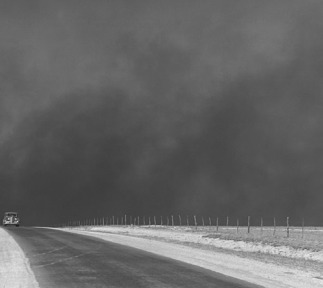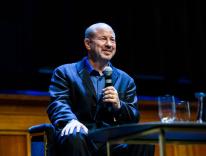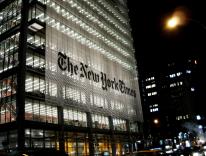The language of the Bible haunts the latest documentary by Ken Burns. There are descriptions of “plagues” that sound like the book of Exodus. At one point, a camera zooms in on an old newspaper bearing a citation from Ezekiel. At another, a solemn voice-over, reading from the work of a long-ago journalist, alludes to Hosea 8:7—“They have sown the wind, and they shall reap the whirlwind.”
 No, Burns is not giving us his take on the Old Testament. His new documentary is The Dust Bowl, airing in two two-hour installments on November 18 and 19, at 8 p.m. (check local listings). A fascinating but sobering account of an environmental cataclysm that transformed the Great Plains into a kind of malevolent Sahara, The Dust Bowl shows people caught in a climate shift so destructive and terrifying it seemed a sign of divine wrath—possibly even a harbinger of apocalypse.
No, Burns is not giving us his take on the Old Testament. His new documentary is The Dust Bowl, airing in two two-hour installments on November 18 and 19, at 8 p.m. (check local listings). A fascinating but sobering account of an environmental cataclysm that transformed the Great Plains into a kind of malevolent Sahara, The Dust Bowl shows people caught in a climate shift so destructive and terrifying it seemed a sign of divine wrath—possibly even a harbinger of apocalypse.
Today, many of us would view the phenomenon through a different lens. As the film explains through voiceover narrative, seamlessly interwoven with scholarly interviews and bracing testimony from Dust Bowl survivors, the ecological disaster on America’s prairies in the 1930s was caused by people tampering with nature. At the beginning of the twentieth century, a chain of events—including the broadening of the Homestead Act, real-estate speculation, and breakthroughs in gas-fueled farm equipment—contributed to a spike in farming on what had been windy grasslands. When a savage drought set in, just after the start of the Great Depression, winds began sweeping up the parched soil, which was no longer anchored by native grasses. As a result, devastating dust storms raged repeatedly through the southern Plains, burying fields, infiltrating houses, suffocating cattle, and infecting people—especially children—with potentially lethal “dust pneumonia.” The Dust Bowl features spectacular photos and film footage of the “black blizzards,” whose roiling dark clouds and pummeling miasmas look like they belong in Mordor. Just as arresting are the first-person accounts by people who grew up during the catastrophe. Interviewees remember coughing up mud; watching a parent crawl through a dust storm to check on a relative in another part of town; hearing cries as a beloved sibling died. One interviewee recalls the rabbit epidemic, when hordes of rabbits, searching the arid region for food, overran fields and gardens, provoking desperate farmers to round the creatures up and club them to death. (A plague of grasshoppers followed.)
You can hardly wonder that people associated their ordeal with darker Old Testament passages, or with the idea of the end times. The harsh conditions of 1935 prompted the Boise City News to quote Ezekiel 22:12–13 on its front page (“I have smitten mine hand at thy dishonest gain”), implying that the disaster was God’s punishment for our sins. And several of the film’s interviewees remember panicked adults predicting the imminent end of the world. (This Cassandra-style mindset inspired Woody Guthrie to write “So Long, It’s Been Good to Know You.”) One former resident of 1930s Colorado recalls feeling that the weather around her was “evil.”
The Dust Bowl also chronicles the region’s turnaround, following the creation of the Civilian Conservation Corps and Soil Conservation Service under Franklin Delano Roosevelt. The erosion-fighting efforts of those agencies, along with the championing of optimal farming practices (such as crop rotation) by SCS head Hugh Bennett, helped the southern Plains heal, a process quickened by the end of the drought. Before the documentary reaches this upbeat denouement, it dwells on examples of courage, generosity, and ingenuity: a housewife sharing precious supplies with refugees; mothers turning patterned feed sacks into children’s dresses; and so on.
Nevertheless, The Dust Bowl brims with tales of anguish and damage to the natural world, and contains little tonal relief—none of the radiant scenery of Burns’s The National Parks (2009), for example. Watching it can be something of a downer. Making the experience all the more unsettling is the fact that the narrative revolves around issues that remain relevant today: the role of government and regulation, the role of the free market, the dangers of riding roughshod over nature.
Of course, by evoking the era so vividly, while explaining its context and causes, The Dust Bowl could prompt some useful soul-searching on climate change. Perhaps not coincidentally, the program’s second half touches on the work of documentary photographers like Dorothea Lange and Arthur Rothstein, who captured the hard lives of farmers, migrants, and others, starting in the 1930s. Roy Stryker, the Resettlement Administration official who spearheaded this “unprecedented documentary effort” believed “that pictures could be a powerful tool,” the film notes. Watching The Dust Bowl, you know Stryker was right.
Please email comments to [email protected] and join the conversation on our Facebook page.
Previous Story
Another group of voters the GOP lost
Next Story
Three Poems

